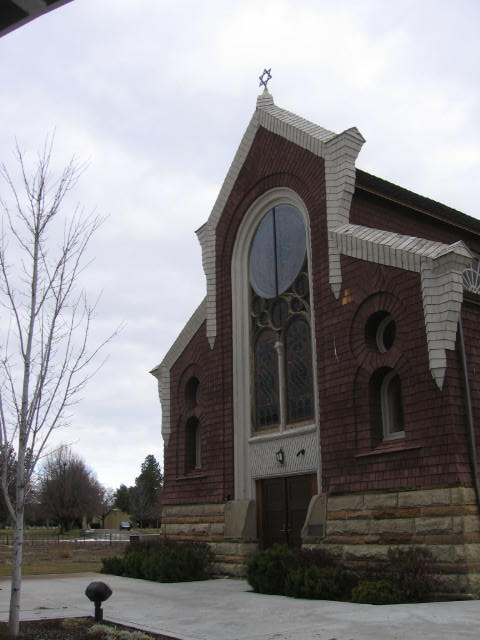Virtual Jewish World: Idaho, United States
Two Jews of unknown name, one of whom reportedly perished, are said to have belonged to a pioneering party that was caught struggling toward shelter in Orofino in the winter of 1861–62, but the first identifiable Jew to have set foot in Idaho was J.D. Farmer, who braved a gold-rush trail from Boise to Call's Fort in January 1864, a month after Idaho was officially declared a territory. A handful of permanent Jewish settlers lived in Boise after 1865 and in Hailey after 1881, when both places were little more than raw mining camps. Most of these early arrivals were hardy young pioneers of German Jewish ancestry; becoming merchants of staples, potato farmers, and ranchers, they generally prospered and were quickly integrated into local life.
 Congregation Ahavath Beth Israel in January 2010 |
In 1895, the first Jewish congregation in Idaho was organized in Boise by Moses Alexander, later mayor of the city and governor of the state. The congregation, called Beth Israel, adopted the Reform ritual and erected a temple in 1896 that is still in use. A B'nai B'rith lodge was formed in Boise in 1899 and a second, Orthodox, congregation, Ahavath Israel, in 1912. In Pocatello, in the southeast, a B'nai B'rith lodge was formed in 1923 and an organized congregation in 1924.
Idaho's tiny Jewish population had no rabbi in 1970. Its three synagogues had lay leaders: two in Boise, whose Jewish community of about 120 was Idaho's largest, and one in Pocatello. Pocatello's Temple Emanuel, dedicated in 1960, is shared by three groups, Orthodox, Conservative, and Reform, each numbering 40 to 50 congregants and including members from outlying districts, and each having its own plot in the city cemetery. There is a Sunday school; Sabbaths and occasionally other holidays are observed, and a community seder is an annual tradition.
Some of the Jewish scientists attached to the Atomic Energy Commission experiment station in nearby Idaho Falls, where there is a Hadassah chapter, also participate in temple life. There are handfuls of Jews in Caldwell, Weiser, Hailey, and at the University of Idaho in Moscow, but aside from the annual statewide United Jewish Appeal there is no organized Jewish life in any of these places, and little interest in adult Jewish learning exists.
The intermarriage rate is low around Boise, higher in the Pocatello region. Since Moses Alexander's time a number of Idaho Jews have served as mayors, state assemblymen, members of state and county commissions, presidents of state associations, heads of county and city civic bodies, and leaders of Masonic lodges. By the mid-1980s, gradually, the two synagogues in Boise (Beth Israel, Reform; Ahavath Israel, originally Orthodox but long Conservative) merged and became Ahavath Beth Israel. It is affiliated with the Reform movement, but serves both Reform and Conservative communities. It now has a full time rabbi, Dan Fink, who has served for more than a decade.
The synagogue is still in its historic synagogue building, erected in 1896 – but no longer located on its original site. In 2003, the building was picked up and moved about three miles to its new location, where a campus was built around it. Boise no longer has a B'nai B'rith lodge, but does have an active Hadassah chapter.
As of spring of 2004, Boise also has a Chabad affiliate. There is also a congregation in Ketchum/Hailey/Sun Valley, which is a resort area for skiing where Jews from other states own homes, that is affiliated with the Reform movement. They do not have a synagogue building but do have a full time rabbi, Martin Levy.
The Jewish Community of Moscow is organized but still does not have a building or rabbi. The Jews of Caldwell, Weiser, Nampa are now part of the Boise metro area. There is a small Jewish community in northern Idaho (Sandpoint and Coeur d'Alene) that is affiliated with the synagogue in Spokane, and an active Jewish community in Pocatello. Pocatello's Temple Emanuel was dedicated in 1960 and also serves congregants from neighboring towns (Rupert, Blackfoot, Idaho Falls, etc). Services are Reform in character, but many in the congregation come from Conservative, and occasionally Orthodox backgrounds. There are Sabbath services on alternative weeks with lively discussions of Torah. Major holidays are celebrated, and there is a children's school and a consecrated cemetery. Too small to hire a rabbi, Temple Emanuel has a long tradition of lay leadership with religious leaders typically serving for many years. The Jews of Temple Emanuel have excellent relations with local churches and mosques, though the small far-right fringe occasionally causes concern.
As of 2017, Idaho's Jewish population was approximately 2,125 people.
Sources: Encyclopaedia Judaica. © 2007 The Gale Group. All Rights Reserved. L.L. Watters, Pioneer Jews of Utah (1952), index; B. Postal and L. Koppman, Jewish Tourist's Guide to the U.S. (1954), index;
Wikipedia.



